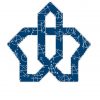Workshop and Seminar
A mathematics teacher and his talented student: Athir al-Din Abhari and his pupil Najm al-Din Qazwini Katibi
Lecture: Jan P. Hogendijk
30 April 2016
The famous Islamic philosopher Najm al-Din Qazwini Katibi (died 675H/1276 CE) studied mathematics and astronomy with his master Athir al-Din Abhari. We will analyse the textbook which Abhari wrote for Katibi and which has been preserved in three Arabic manuscripts (Tehran, Majlis 6195, Tehran , Milli 20371 bis). We will analyse the textbook which Abhari wrote for Katibi and which has been preserved in three Arabic manuscripts (Tehran, Majlis 6195, Tehran , Milli 20371 bis). The textbook includes mathematics (trisection of the angle, trigonometry, theorems on the sphere), abstract discussion of astronomical problems, concrete results of astronomical researches, as well as astronomical tables. As we will see, Abhari followed a special didactical approach for his talented student. Abhari explained the theory completely and did not avoid any difficulty, but the explanations were very brief, as compared to the work of authors from the same century such as Nasir al-Din Tusi.
Non-Linear Dimensionality Reduction by Isometric Patch Alignment
Professor Ali Ghodsi, Waterloo University
27 Apr. 2016
Abstract: We propose a novel dimensionality reduction method which has low computational cost. This method is inspired by two key observations: (i) the structure of reasonably large patchesof high-dimensional data can be preserved as a whole, rather than divided into small neighborhoods; and (ii) attaching two neighboring patches will align them such that the overall rank does not increase. In the proposed approach, first the data is clustered, so that it is conceptually reduced to a set of overlapping low-rank clusters. Each cluster is embedded into a low-dimensional patch and then all of the patches are rearranged such that their border points are matched. We show that the rearrangement can be computed by solving a relatively small semide nite program. The embedding computed by this optimization is provably low-rank. The proposed method is stable, fast and scalable; experimental results demonstrate its capability for manifold learning, data visualization, and even complex tasks such as protein structure determination.
Why mathematics is taught to schoolchildren?
Toghyan Angoshtari
23 Apr. 2016
This question is a key; because this well-reasoned and persuasive answer may be useful in teaching children.
In order to provide a definitive answer to this fundamental question, a scientific and documentary unity about three concepts; Children, Education and Mathematics, should be achieved first. After that, it will be possible to agree on the obtained answers.
It will be shown that the education of mathematic, can have very useful and unique role to, in promoting education, development and children awareness. Along with it, updating methods of education mathematics to children will also be revealed.
Simultaneous estimation and Wonders of high Dimensions
Dr. kasra Alishahi
11 Mar. 2015
Series of IMH lectures
26 Jan. 2015
Lecture by Dr. M. Mirzavaziri (Ferdowsi University of Mashhad)
For high school students, 2nd-grade (Pairwise Intersecting figures)
For Teachers (Systematic Table)
Lecture by Dr. O. Naghshine Arjmand (AmirKabir University)
For University Students (From Pythagorean theorem to Fourier series)
Lecture by Mr. M. Hosseini (Math Highschool Teacher)
For Teachers (What are main factors of math phobia and
What are the obstacles of students motivation to solve mathematical problems?)
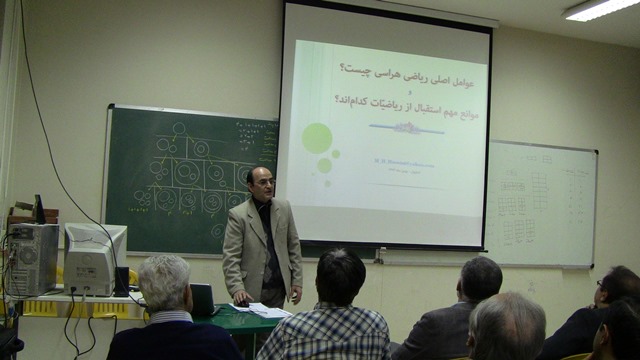
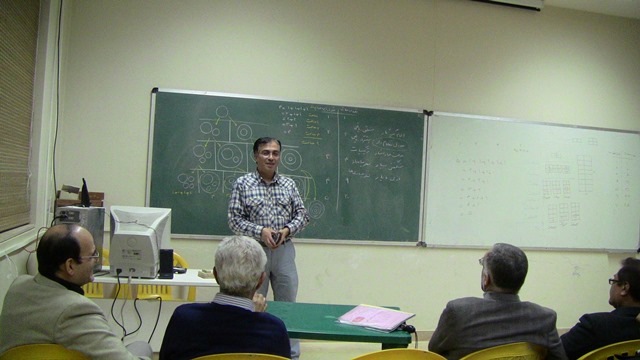
Data Clustering, A Bayesian View
8 Aug. 2014, 17:30
Clustering refers to estimating a grouping for data. Data grouping is a basis for knowledge extraction from information and therefore a very important problem in any scientific discipline. This talk focuses on explaining why clustering is a challenging issue. We describe how one can formalize clustering as a mathematical problem. Statisticians understand the world through a probabilistic model. Hence, as a statistician, I focus on methodologies that applies this approach.
Handling clustering in Bayesian paradigm is more coherent in terms of combining uncertainties and merging prior knowledge with data information, and I will emphasize on this paradigm throughout the talk. Important challenges and open problems of this context are discussed at the end.

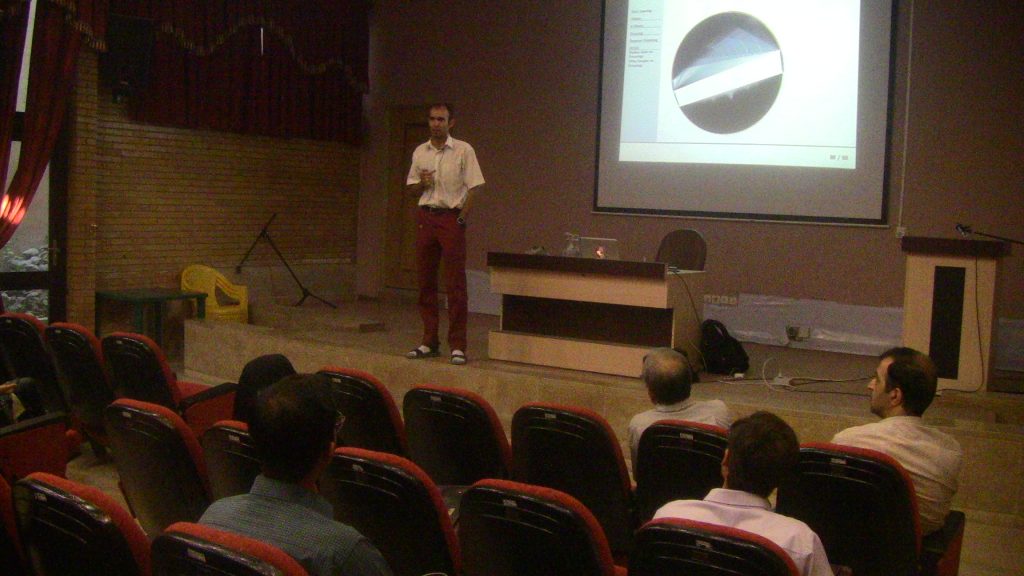
Life Tables
Terry Mills (Australia)
1 Sep. 2014
Honorary Statistician at Bendigo Health
Emeritus Professor at La Trobe University
Abstract: Life tables are mathematical tables that describe death rates at different ages in a society. Thus, the life table contains some essential features of the health of a nation. One can calculate life expectancy of a population from a life table. We will examine life tables from a mathematical point of view. Probability is often regarded as a difficult branch of mathematics. Life tables provide an effective approach to introducing concepts in probability. Difficult concepts such as conditional probability become easy to understand when presented in the context of a life table. Furthermore, the mathematical models that underpin life tables are applications of calculus and more advanced notions in probability. A few books that contain information about life tables are listed below in the references. This paper has been written in collaboration with Dr Mehdi Hassani (University of Zanjan).
References
C.L. Chiang, Introduction to stochastic processes in biostatistics. New York: John Wiley, 1968.
C.L. Chiang, Life table and its applications. Malabar, FL: Robert E. Krieger, 1984.
N. Keyfitz, Applied mathematical demography. New York: Springer-Verlag, 1977.
N. Keyfitz and J. A. Beekman, Demography through problems. New York: Springer-Verlag, 1984.
K. Namboodiri and C. M. Suchindran, Life table techniques and their applications. Orlando: Academic Press, 1987.
J.H. Pollard, Mathematical models for the growth of human populations. Cambridge: Cambridge University Press, 1973.
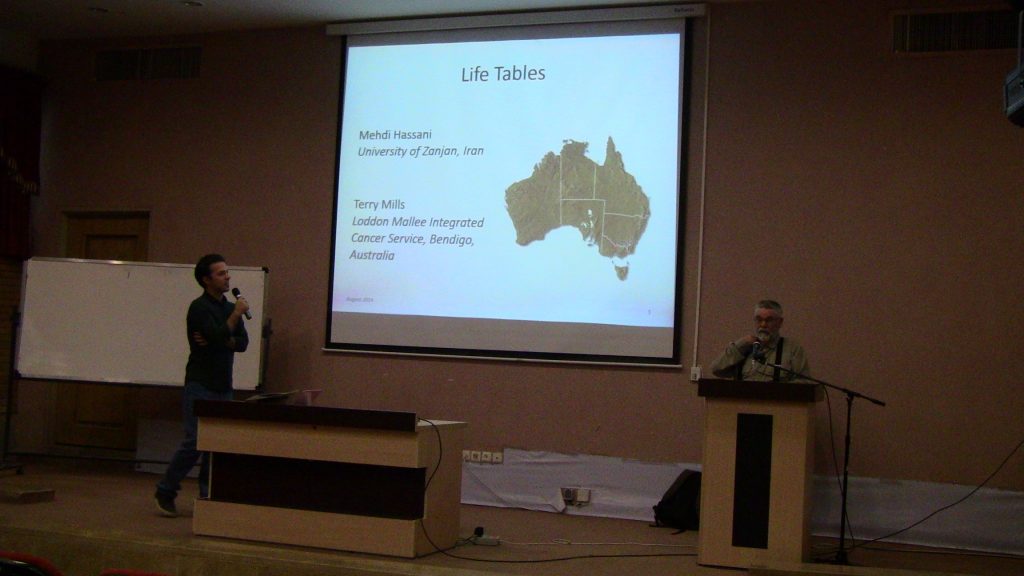
The founders of mathematics
Akbar Zamani
6 August 2014
In this lecture, we will talk about Babylonian and Egyptian mathematics, and then briefly talk about works of Pythagoreans, Euclid, al-Khwarizmi, Pascal, Descartes, Newton and Neper.
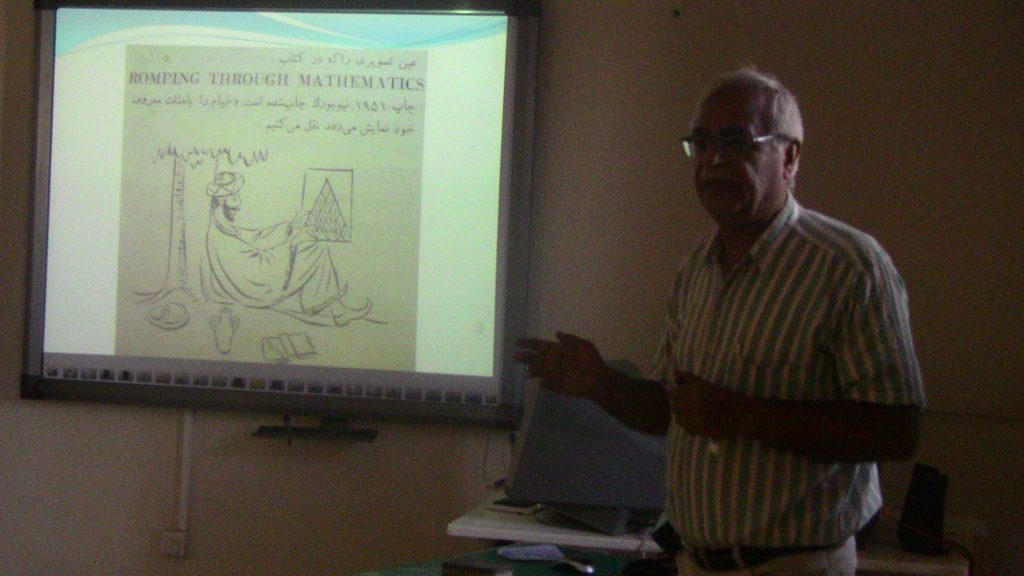
Evolutionary history of number set
Payam Seraji
6 August 2014
In this lecture, we will briefly talk about the evolutionary history of natural numbers and real systems, the theory of infinite sets as well as historical facts about some specific numbers, such as numbers and pi and Neper number.
IMH public lecture Series, 14-19, April 2014
| Prof. Gregor Nickel | History and Philosophy of Mathematics for Teacher’s Education Full Text | 17 – 16, 14 April | |
| Prof. Gregor Nickel | Proof – Aspects of a strange phenomenon between freedom and enforcement Full Text | 17:30, 15 April | |
| Roeland Hiele | Flipping the classroom | 17-19, 19 April | |
Prof. Jan P.Hogendijk | Abu Rayhan Biruni in the 15th/21th century | 17-19, 19 April
| |
| Vincent Karels M.Sc | Research Group in History of Mathematics | A mathematical analysis of the dome of the shrine of Shah Nematollah Vali at Mahan | 17-19, 19 April |
History and Philosophy of Mathematics for Teacher’s Education
The talk will analyse various functions of history and philosophy of mathematics as a tool to improve the quality of teacher’s studies. In the second part these two disciplines will be discussed as a goal in themselves – being an essential part of any mathematical literacy. In a third part I will briefly report some of my concrete experiences from an integration of history and philosophy to teachers’s studies at Siegen University.
Proof – Aspects of a strange phenomenon between freedom and enforcement
Proofs play a major role in the everyday life of any mathematician. Undoubtedly, since the time of the ancient Greeks mathematics deals to a large extent with `proofs’. However, the question for the functioning and the function of mathematical proofs remains open. Working mathematicians agree, that a proof proves, but do not ask, how this really works. The talk will discuss various `non-formal’ aspects of mathematical proof – mostly regarding a proof as a special type of communication. Thereby we also refer to the classical controversy in the philosophy of mathematics which tried to decide whether proof is either synthetic or analytic.
Flipping the classroom
Using specific examples I will show how instruction videos can be used to expand the possibilities in and bring variety and interactivity to classroom teaching. This approach can be called the flipping-the-classroom model. Together with the audience, we will reflect on the following questions: what are the strengths, weaknesses, opportunities and threats of this flipping-the-classroom model? What are the possibilities in class?
A mathematical analysis of the dome of the shrine of Shah Nematollah Vali at Mahan
Using modern computer methods and photos of the entire dome in Mahan, we have analyzed the pattern on the dome and its possible design. According to our analyses, which we will present during the talk, the number 11 had a significant influence at various stages of the design. We will show several approaches but have not yet been able to explain all details in the interesting design. g
Abu Rayhan Biruni in the 15th/21th century
Abu Rayhan Biruni (born 365 H.Q. /973 CE, died ca. 440 H.Q. / 1048 CE), was one of the most important astronomers and mathematicians of the medieval Islamic tradition. He also wrote extensively on chronology, history and Indian culture and astronomy and has received universal praise for his objective approach and his respect for different religions and cultures. The talk will give an overview of Biruni’s extant (and lost) work, listing the number of extant manuscripts, and the published editions and translations into many languages. I will then indicate several (small and large) research projects on him that
can be done, and also some new questions that can be asked about him, using the new technology of the internet age (the 15th/21th century). In connection with this lecture, a special bibliographic website has been created http://www.albiruni.nl .
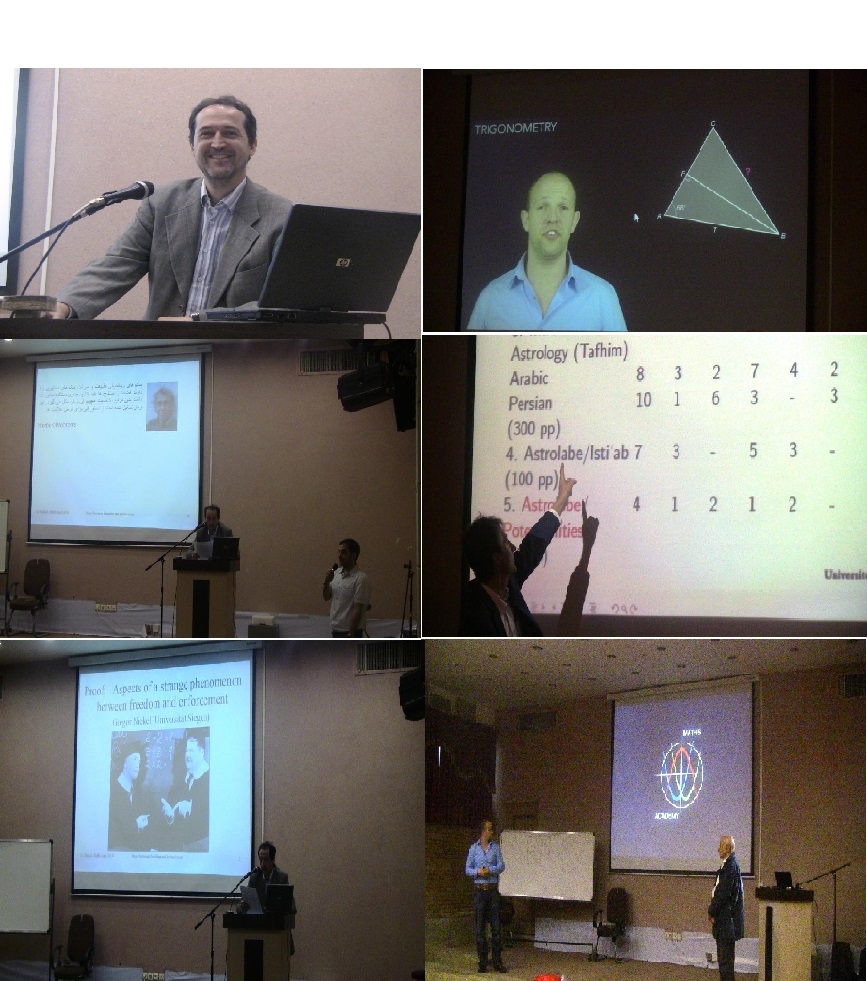
Self similarity for Penrose and Isfahan patterns
Professor Jost –Hinrich Eschenburg
13 March 2014
Abstact :
Planar patterns can express the idea of infinity in two different ways: By repetition (periodicity) or by self-similarity, where the same details appear on different scales. Self Similarity is less obvious than periodicity; therefore it does not occur too often in arts. One of the sites it occurs is Isfahan, at Darb-i-Imam Shrine, at one of the Iwans of Friday Mosque and some other places. These 300 years old patterns have much in common with the aperidic patterns discovered only 40 years ago by the mathematician Roger Penrose; in fact there is a large coincidence between the two patterns. Both have in common the idea of self-similarity and the local pentagonal symmetry. However, there are differences: The Isfahan pattern has a global dekagonal (10-gon) symmetry which is not shared by the Penrose patterns. However, the coincidence of both patterns sheds some light on the Penrose patterns, too. It uncovers a new Penrose pattern with a hidden approximate 10-gon-symmetry. The new pattern does not arise by the common construction which uses a projection of part of the 5-dimensional periodic grid onto some plane in 5-space (“projection method”). Thus a 300 year old Iranian art work has some influence on todays mathematics.
Virtual Education
University Utrecht, Holland
3 Mar. 2014
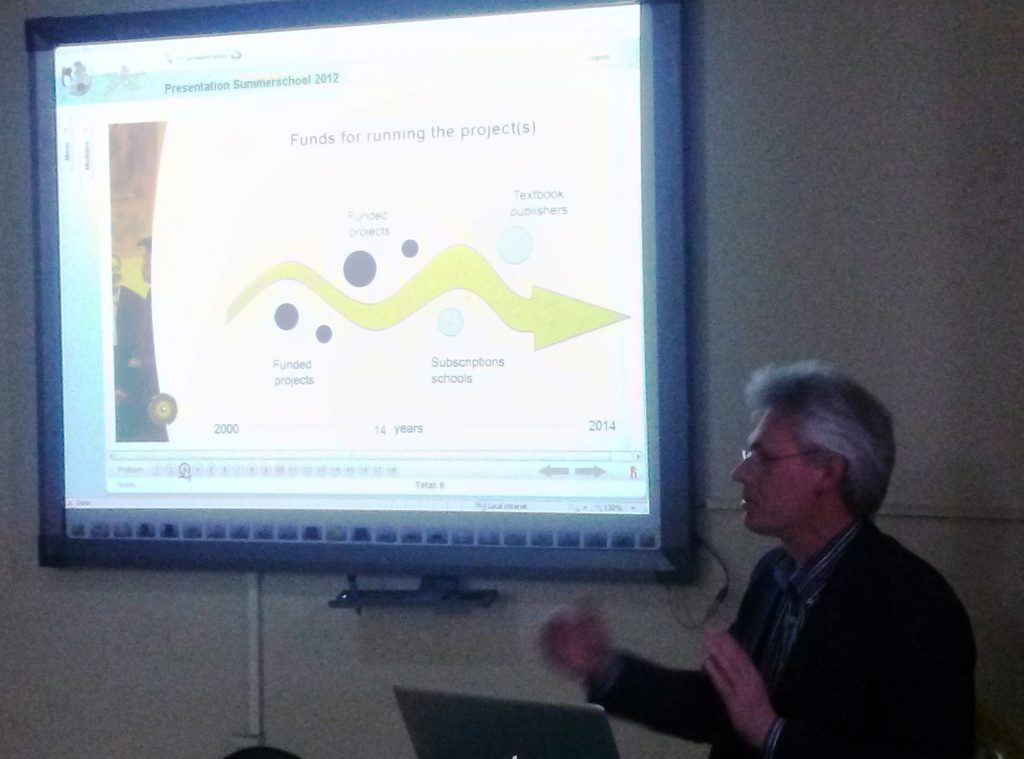
Clockwork gearing in ancient Greece and Medieval Islam
Dr. J.L.Berggren
Isfahan Mathematics House
1 March 2014
In its general lectures on mathematics, IMH is organizing a lecture on Clockwork gearing in ancient Greece and Medieval Islam. This Lecture is delivered by Dr. J.L. Berggren professor of Simon Fraser University, Canada om 1 March 2014.
Publications by J.L. Berggren
Abstract :
The chance discovery in 1900 of an ancient shipwreck off the Greek island of Antikythera led to the recovery of some corroded fragments of what turned out to be the earliest known example of precision gearing. Our illustrated talk will tell a fascinating story of how the combined efforts of archaeologists, historians of science and the latest imaging technology have led to the reconstruction of an ancient Greek geared calendar-computer and a complete revision of our views of Greek technology. From this mechanism we will follow the history of precision gearing through the Islamic medieval period, including the geared astrolabes of al-Biruni and Muhammad ibn Abi Bakr of Isfahan, which contain many features similar to those in the Antikythera mechanism.
Dr. Len Berggren is Emeritus Professor of Mathematics at Simon Fraser University in British Columbia, Canada, He was introduced to the Antikythera mechanism by Prof. Derek Price, who did the first study of that instrument using imaging technology, during a visiting year at Yale University in 1972. Prof. Berggren has lectured at major universities around the world and is known internationally as an authority on the history of mathematics and astronomy in ancient Greece and medieval Islam. Among his publications are translations of Greek scientific works by Euclid, Claudius Ptolemy and Geminus, as well as Episodes in the Mathematics of Medieval Islam, which has been translated into German and Farsi.
In its general lectures on mathematics, IMH is organizing a lecture on the current mathematics education in France. This Lecture is delivered by Prof. Martin Andler, Professor of Mathematics, Université de Versailles Saint-Quentin (UVSQ), on Monday 1st December 2008
“The lecture will start with a brief overview of the organizations of education at junior High School and High School level in France, and the ongoing changes. The second topic will be the evolution of the mathematics curriculum between the 1960’s and now, including the controversies around the introduction of “New math” in the 70’s, and the present state of affairs. I will then discuss the role of extracurricular math activities in France, and what is done to develop them.
Teaching Students to Think Mathematically, Prof. Kaye Christine Stacey
 Prof. Kaye Christine Stacey from University of Melbourne (Melbourne, Australia) delivered a lecture at Isfahan Mathematics House on Sunday Aug 9. In her talk Prof. Kaye Stacey whose research interests are: Curriculum studies: mathematics education; Educational technology and media; Teacher education; Mathematical thinking and problem-solving addressed the issue of problem solving strategies.
Prof. Kaye Christine Stacey from University of Melbourne (Melbourne, Australia) delivered a lecture at Isfahan Mathematics House on Sunday Aug 9. In her talk Prof. Kaye Stacey whose research interests are: Curriculum studies: mathematics education; Educational technology and media; Teacher education; Mathematical thinking and problem-solving addressed the issue of problem solving strategies.
“I will discuss a mathematical problem which can be used to teach students to think mathematically and to solve mathematical problems that are unfamiliar and new to them. The processes of looking at special cases, generalizing, conjecturing and convincing will be highlighted through these examples; these are key processes in thinking mathematically”
The Gems of Combinatorial Geometry, Professor Paul Vaderlind

“Combinatorial geometry is one of those few branches of mathematics that offer almost an immediate access to a variety of open problems.
In this talk several such problems will be presented. Although many of them are quite natural and have been formulated some time ago, the final answers are still not known and the problems offer some
excellent topics for the research. Except for the basic knowledge of geometry, no other prior knowledge of combinatorial geometry is needed.”
Professor Jan Hogendijk’s Lecture on “History of Mathematics” in Isfahan On Saturday, Dec 29, 2007, Professor Jan Hogendijk, from Utrecht and Leiden Universities in the Netherlands delivered a lecture in Isfahan. This lecture was focused on the history of mathematics in the Netherlands during 16th and 17th centuries and its relationships and similarities with the history of Islamic –Iranian mathematics during 4th – 5th of Hijrah.

Professor Hogendijk mentioned that the main transmission of Islamic mathematics from the Islamic world to Europe started in 11th and 12th centuries which took place in Spain and Sicily and then to Europe; therefore most of the results in mathematics in the Netherlands in 16th and 17th centuries were taken from European resources, and not directly from the Islamic sources.
Comparing the two traditions, he stated that around 1600, mathematics in Holland was almost on the same level as mathematics in Iran in 14th -15th centuries. The Dutch mathematicians were working independently on the same problems which interested Iranian mathematicians two centuries earlier. One example is the discovery of the decimal fractions which happened independently by the Iranian mathematician Kashi and by the west mathematician Simon Stephen. Also the most particular example is the computation of the number π.
Referring to the Dutch translation of the “Elements” (1695), which is preserved in the library of Leiden University, professor Hogendijk confirmed that in this book there are references to Iranian mathematicians, Ali Abul Hasan Nasawi, Nasir Al-Din Tusi and Abu Sahl Kuhi.
In the end, professor Hogendijk clarified some advantages of studying history of mathematics in the development of mathematical sciences, in particular in the improvement of mathematics education.
Before his lecture, professor Hogendijk thanked Isfahan Mathematics House for inviting him and his students and pointed out that since its establishment, Isfahan Mathematics House and the two universities of Leiden and Utrecht have had many cooperation projects and in recent years this cooperation has remarkably increased.
Teaching Mathematics as a Constructive and Creative Activity
 On Thursday, September 6, 2006, Professor John Mason, Professor of London Open University delivered a lecture at Isfahan Mathematics House. This lecture was on: Teaching Mathematics as a Constructive and Creative Activity
On Thursday, September 6, 2006, Professor John Mason, Professor of London Open University delivered a lecture at Isfahan Mathematics House. This lecture was on: Teaching Mathematics as a Constructive and Creative Activity
“I will invite participants to engage in some mathematical tasks which call upon the learner to construct mathematical objects, and offer the conjecture that this not only engages learners actively, but calls on their natural powers to make sense of mathematics and to make sense mathematically. Using construction tasks in teaching, not only displays mathematics as a constructive activity, but engages the teacher in constructive and creative activity as well”.
The CD of this lecture is available at Isfahan Mathematics House library.
Psycho Acoustic, Applications of Statistics in Biology, by Dr. Gazor
Dr.Saeed Gazor, the professor of Queen’s University of Canada visited Isfahan Mathematics House on April 23, 2006 and delivered a lecture for the members of Isfahan Mathematics House.
In his lecture, Dr. Gazor first gave some explanations on the human auditory system and then noted some applications of statistics in biology and technology with respect to this system.
In continuation, he mentioned that statistics helps physicians and researchers in artificial making of the inner members of ears, and it also helps engineers to omit or replace sounds in an optimized way through the recorded tapes.
He pointed out that recently scientists have discovered that the human ear makes sounds all by itself; it means, the sounds produced- as guessed by psychologists, relate to the different mental states of human. He, along with a team of psychologists, are studying the case and continuing to research in this field.
If you are interested in following up this topic, you may receive the CD of his speech at the Library of Isfahan Mathematics House.
.jpg) lecture on Iranian qanats and Roman aqueducts
lecture on Iranian qanats and Roman aqueducts
Wilke Schram M.Sc, 7 may, 18:30
The Scale of Pythagoras and intervals of traditional Persian Music ( part one )
Payam Seraji – Lecturer –Department of Computer Science – Shiekh Bahee University – Isfahan – Iran
21th September 2006
Time : 5 PM
Venue : Isfahan Mathematics House
The Scale of Pythagoras and intervals of traditional Persian Music ( part two )
Payam Seraji – Lecturer –Department of Computer Science – Shiekh Bahee University – Isfahan – Iran
28th September 2006
Time : 5:15 PM
Venue : Isfahan Mathematics House
Art and Science in Islamic Countries
November 16th 2005
Professor Ahmed Djebbar – University of Science and Chronology of Lille – France
Time : 5 – 5:45 PM
Venue : House of Mathematics of Isfahan
Symmetry in Islamic Decoration Arts
Professor Bernard Maitte – University of Science and Chronology of Lille – France
16th November 2005
Time : 6 – 6:45 PM
Venue : House of Mathematics of Isfahan
Khulasat al-hisab of Baha’ al-Din Amili from the point of view of modern mathematics
Abdol Hossein Moshafi – A leading teacher and author of high school mathematics texts – founder of the journal of “Yekkan” a basic mathematics journal – Yazd – Iran
7th December 2005
Time : 5 – 6 PM
Venue : House of Mathematics of Isfahan
[ Abstract ] :
In this talk some of the mathematical concepts used by Baha’ al-Din Amili in his Khulasat al-hisab, along with their background in previous sources, as well as their present expressions and definitions will be discussed.
lebesgue’s historic paper on integral
Dr.Arsalan Shademan – University of Tehran – Tehran – Iran
December 14th 2005
Time : 5 – 6 PM
Venue : House of Mathematics of Isfahan
The mathematical and historical background of a newly discovered instrument for finding the direction and distance of Makka
Professor Jan Hogendijk – Department of Mathematics – University of Utrecht – The Netherlands
16th April 2004
Time: 9 -11 PM
Venue: Central Library – Isfahan Municipality
[ Sheets ]
[ Literature ]
[ Detail of the qibla instrument ]
- The mathematical and historical background of a newly discovered instrument for finding the direction and distance of Mekka
- · Literature for the on the mathematical and historical background of a newly discovered instrument for finding the direction and distance of Mekka
- · A computation from Chapter 7 of Book 6 of al_Biruni , al_Qanun al_ Masudi
- · The mathematical methodology of Islamic astronomy
The mathematical methodology of medieval Islamic astronomy: the example of al-Biruni
Professor Jan Hogendijk – Department of Mathematics – University of Utrecht – The Netherlands
12th April 2004
Time: 3-5 PM
Venue: Central Library – Isfahan Municipality
[ Sheets ]
[ English translation and figure ]
The mathematical methodology of Islamic astronomy
Jaghmini’s Mulakhkhas: Its importance for the History of Science and Islamic Civilization
Sally P. Ragep – Associate Scholar – Department of the History of Science – The University of Oklahoma – USA
26th May 2004
Time: 5 – 6:15 PM
Venue: Central Library – Isfahan Municipality
[ Power Point ]
[ Abstract ] :
Jaghmini’s Mulakhkhas: Its importance for the History of Science and Islamic Civilization
Abstract
al-Jaghmini is the relatively unknown early thirteenth-century author of the ubiquitous elementary astronomical text al-Mulakhkhas fi al-hay’a al-basita (Epitome of plain theoretical astronomy). Yet his simplified introduction to astronomy became the subject of an enormous number of extant commentaries and super-commentaries. These commentaries (many written in Persian as well as Arabic) were studied along with the Mulakhkhas and used as propaedeutics for more advanced teaching texts. The continuous chain of astronomical learning represented by al-Jaghmini’s Mulakhkhas and its commentaries and super-commentaries–one that extended for a period of over 500 years—is a significant indication of an active, ongoing educational tradition within Islam.
The Earth’s Motion in Cultural and Religious Context: Historical Perspectives from Islam and Europe”
“Tusi and Copernicus: The Question of the Earth’s Motion”
F. Jamil Ragep – Professor of the History of Science – The University of Oklahoma – USA
26th May 2004
Time : 6:30 – 7:30 PM
Venue: Central Library – Isfahan Municipality
[ Power Point ]
[ Abstract ] :
The Earth’s Motion in Cultural and Religious Context: Historical Perspectives from Islam and Europe
“Tusi and Copernicus: The Question of the Earth’s Motion”
Abstract
A passage in Copernicus’s De Revolutionibus regarding the rotation of the Earth provides evidence that he was aware, whether directly or indirectly, of an Islamic tradition dealing with this problem that goes back to Nasir al-Din al-Tusi (1201-1274). The most striking similarity is the use of comets by both astronomers to discredit Ptolemy’s “proofs” in the Almagest that depended upon observational evidence. The manner in which this question was dealt with by Copernicus, as an astronomical rather than natural philosophical matter, also argues for his being
within the tradition of late medieval Islamic astronomy, more so than that of medieval Latin scholasticism. This of course is bolstered by his use of non-Ptolemaic models, such as the Tusi couple, that have a long history in Islam but virtually none in medieval Europe. Finally, al-Qushji, who was in Istanbul just before Copernicus was born, entertained the possibility of the Earth’s rotation; this opens up the possibility of non-textual transmission.
Combinatorics and geometry of random tilings from microscopic to macroscopic scales
Cédric Boutillier
28 Apr. 2016
Industry challenges, opportunities of computer science
Alireza Haghshenas
8 Mar. 2015
New bounds on the average data rate of secret sharing schemes
for weighted threshold access structures based on the Graph
5 Mar. 2015
Maryam Barati
Undeniable signatures with no certification using a two-line maps
5 Mar. 2015
Zahra Malek
A review of structure and dynamics of complex networks
Keivan Aghababaei
22 Jan. 2015
Recently Complex Networks widely used in various fields of Science from sociology, life sciences to communication engineering and economics. Many complex structures can be modeled by complex networks. Understanding the structure and function of these networks and relationship between the structure and dynamics of networks, is a topics that is considered by researchers in various fields of science and technology. The basic mathematical tool in the study of complex networks is graph theory.
In this lecture, after a brief reviewing of complex networks applications and important network models, several related dynamic process will be discussed.
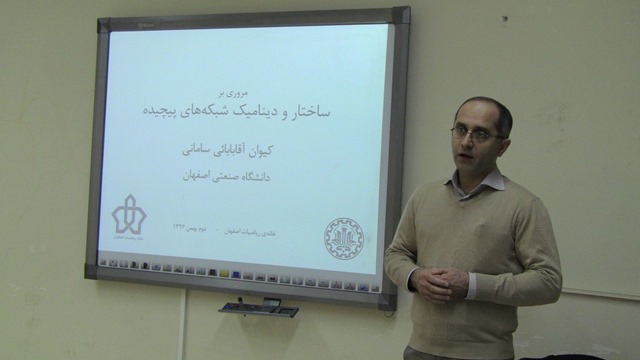
A story of Rostam and sunflowers application in Computer Science
25 Dec. 2014
Navid Nasr Esfahani
In this seminar we will introduce Cell Probe Model, solution and its application in computer science.
Second Workshop on Introduction to Cryptography and Network Security
18 Dec. 2014
A. Hadipoor
S. Ghafoori
Seminar on Architecture and Music
by : Fereydun Farahani
Isfahan University of the Arts
IMH , 20 Nov. 2014
In different periods of art history, link and similarity of architecture and music, is frequently mentioned. Architecture and music have always been subjective expression and similar way of manifestation. Architecture in the context of location, with visual elements and Music at the time with audio elements.
Both, far from objective and conventional forms, embody only mathematical ratios. It Can be described from Sensory experience viewing angle, Encounter architecture and music.
Human movement in architectural space, creates mentally feelings of quality architectural elements and features in place. In the same way, movement of musical notes in human ear creates the mental space that combines musical elements in the context of the time.
1st Workshop on Information Theory and Communiations
10 May 2014
Isfahan Mathematics House
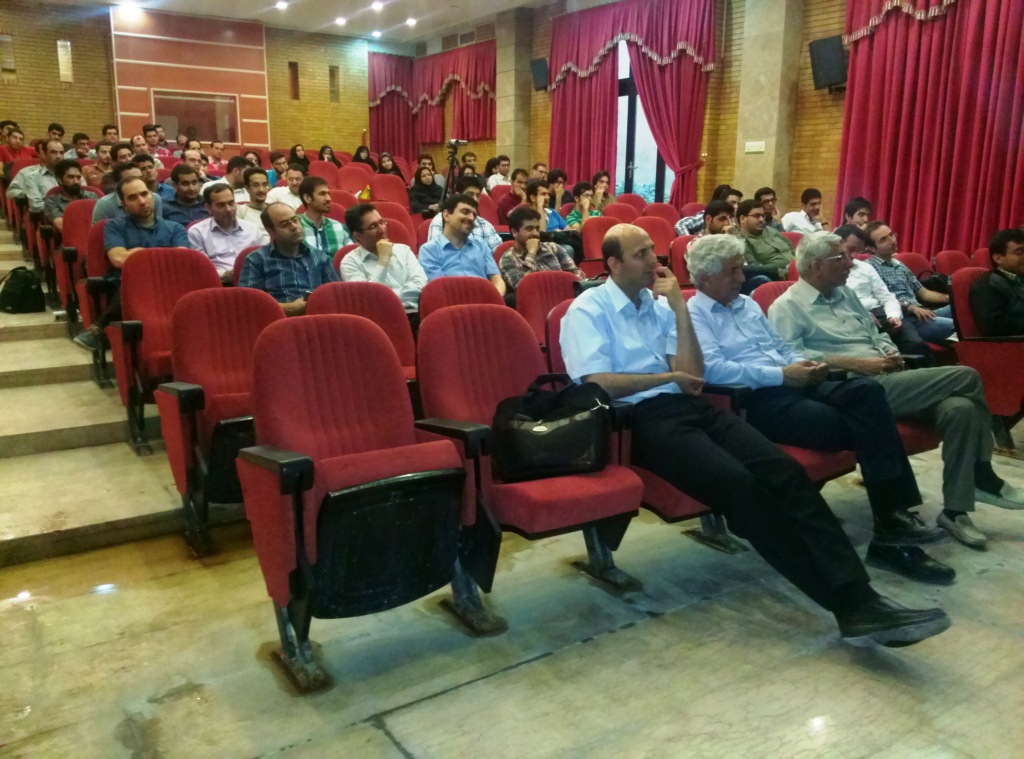
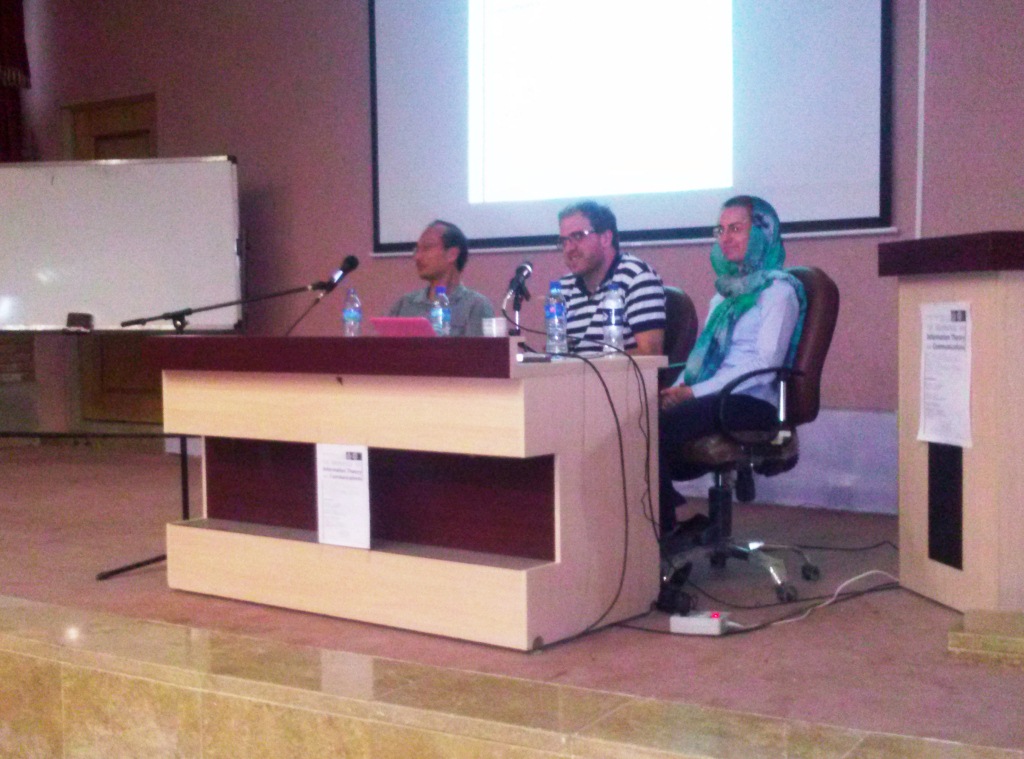
Statistics and Manufacturing
Hamid Reza Sanei
25 Sep. 2014
Different applications of statistics in different fields of industry will be introduced In this seminar. Also, usage of statistical tools in quality control, engineering, marketing, sales analysis and financial matters related to the industry will be examined. In this seminar, we will see how simple and advanced statistical methods in the areas mentioned above, are commonly used. These methods include sampling, regression, descriptive statistics, time series. Here we will examine how the statistics offers improved and scientific methods to solve industrial problems.
Introduction to Game Theory
Soroush Haj Zargarzadeh
8 Jul. 2014
Abstract : Game theory is a study of strategies. Game Theory is every strategic situation that can sometimes carries a conflict of interest and sometime has a spirit of cooperation. Game Theory is the science of studying games and modeling in strategic situations. We will try to convey an overview of Game Theory. Concepts such as Nash equilibrium and the Best Response in the space of pure strategies will be discussed. In addition we will analyze some examples of its applications as an major field of mathematics in sciences, especially economics and examples such as Duopoly and Election system will be investigated.
Workshop on Flight and Rescue Eggs Competition
16,17 April 2014
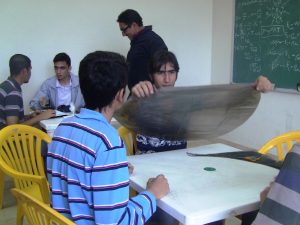
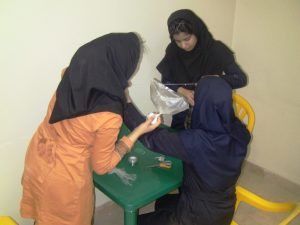

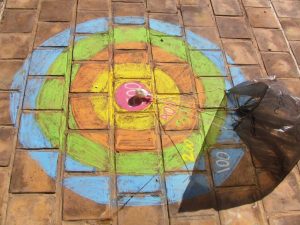
Introduction to Bioinformatics
Ehsan Haghshenas
17 April 2014, 17:30
Bioinformatics is an interdisciplinary scientific field that develops methods for storing, retrieving, organizing and analyzing biological data. The main goal of Bioinformatics is better and more understanding of biological processes, not through the laboratory practices but by designing algorithm and software and using computational techniques based on algorithms and techniques. The use of mathematical models and statistical methods to solve problems in bioinformatics is also very common in Bioinformatics.
First, we will introduce this relatively new field that is growing rapidly. Then learn more about the issue de novo genome assembly as an example of the issues that will be considered in this research area.
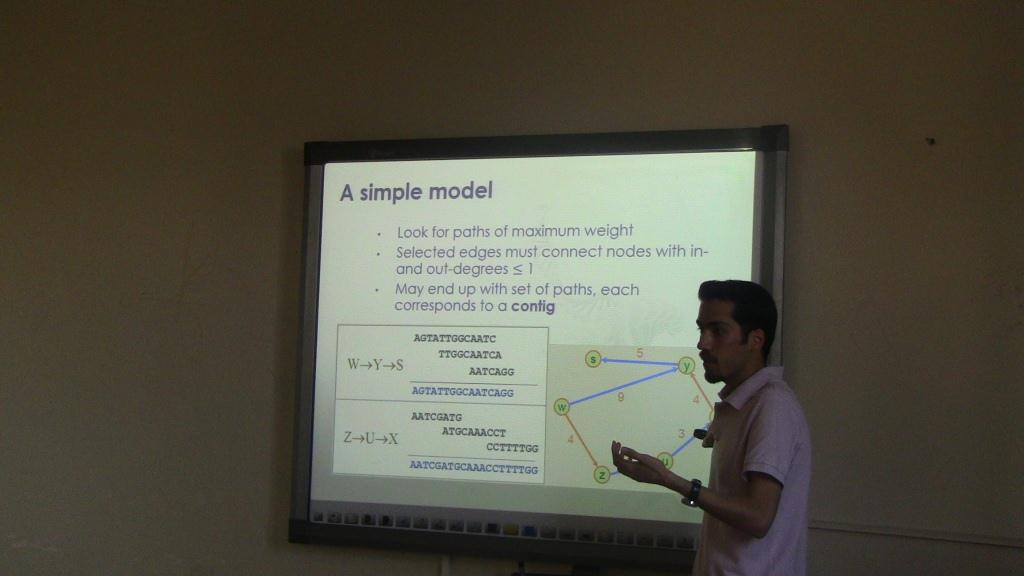
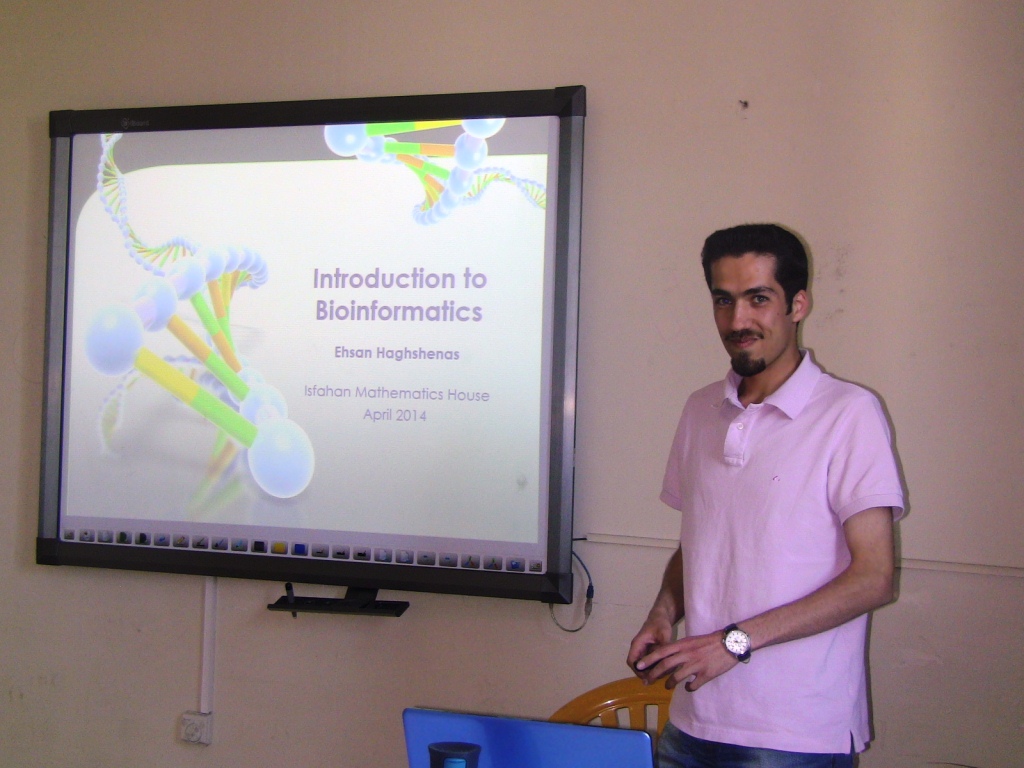
Lecturer: Emran Moradi
The Shadows of the Truth
In this lecture we attempt to demonstrate the effectiveness of fuzzy logic within the depth of classical logic without any preferential approach. The problem is what we expect from mathematics. The mathematics we follow, is it obtained by imitation or by inquiry and research?Perhaps, when he created this theory, Lotfali Zadeh the father of fuzzy logic, didn’t anticipate a serious revolution in the field of logic.
For more information please contact
research_rings@mathhouse.org
A little more than 30 years ago, the French mathematician Alain Connes realized a procedure can in fact be applied to areas of mathematics where the classical notions of space looses its applicability and pertinence and can be replaced by the new ideas of space, represented by a noncommutative algebra.
Connes’ theory which is generally known as noncommutative geometry isa rapidly growing new area of mathematics that interacts with and contributes too many disciplines in mathematics and physics.
This talk gives an elementary introduction to the basic ideas of noncommutative geometry as a mathematical theory with some remarks on its applications. Concepts will be emphasized and technical details avoided.
For more information please contact
research_rings@mathhouse.org
e_ranaei@hrcglobal.net
You have certainly heard about higher dimensions e.g. the 4th dimension. In this seminar we are not offering something new but giving a description of the structure of the perceptible universe around us, from relativity point of view. Without involving formulas and making any specific conclusions, we are making a mental attempt for giving a schematic description of the structure of the universe from a higher dimension perspective. We consider the relationships between these perspectives, relativity theory and cosmology in describing the structure of the universe.
For more information please contact
research_rings@mathhouse.org
Coordinating agents in a multi-agent system is one of the most important tasks in studying these systems. Finding, designing and implementing coordination strategies, if not impossible, is very difficult to achieve. Today, the field of multi-agent machine learning gives a new approach for how to coordinate agents in modern multi-agent systems.
In this seminar, genetic network programming is applied to coordinate agents in (predator-prey) pursuit domains and we study the rates of success and effectiveness of this procedure.
Face recognition is a research area that has become very popular in recent years. In general, given a fixed image the main objective is to identify an individual, by using the information on a database.
Variation in lighting and pose of the face are some of the obstacles preventing recognition of a face in a crude image.
To solve this problem we use mathematical tools. Face recognition could be considered as pattern recognition in high-dimensional vector spaces. But in general the dimensions and components of a face are much less than those seen in a crude image. This is the beginning for using statistical methods and state spaces such as PCA (Principal Component Analysis) and ICA (Independent Component Analysis) which have proved to be very helpful among face recognition algorithms, because of their ability to decrease the dimensions and therefore easier to apply.
The accuracy of the results, using these methods depends to a great extent on the accuracy of the extraction of facial features out of the eigenfaces. Therefore, implementing feature extraction techniques before PCA and ICA increases accurate recognition percentage.
Wavelet transformation is one of the methods used for feature extraction. Using this method, the face is divided into different frequency components and prepared for image processing in state spaces.
